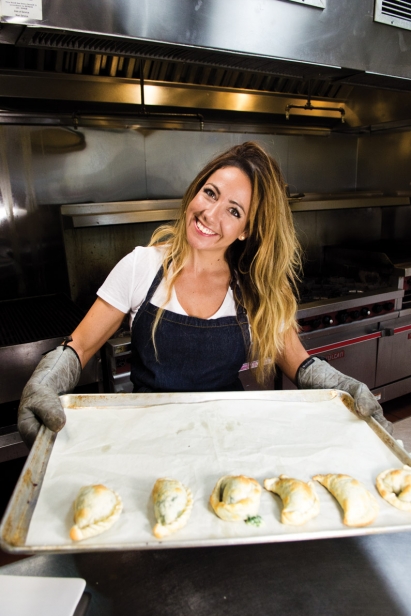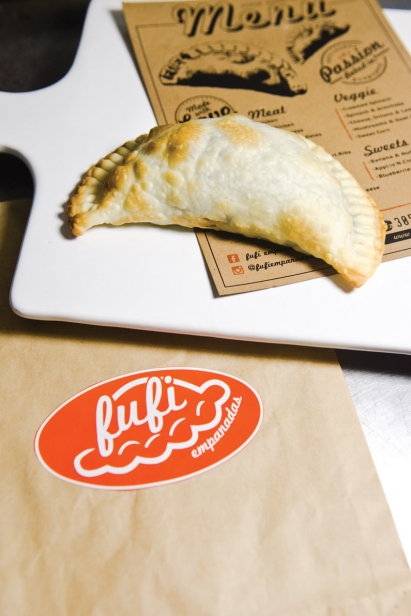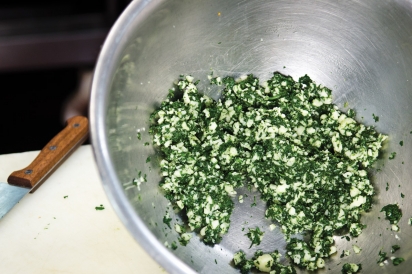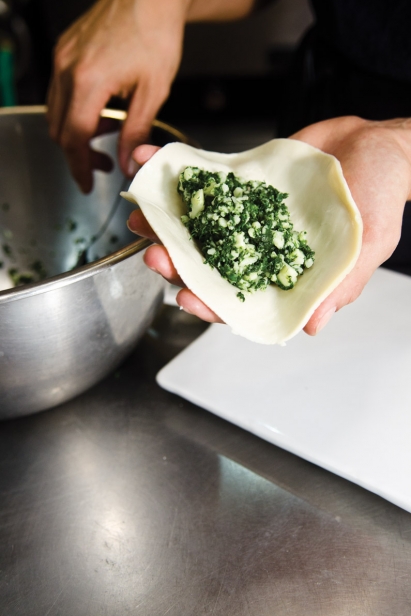Elevating Empanadas
Florencia Anaya likes to tell people she really doesn’t have a family culinary background. Her mother didn’t cook and neither did her grandmothers – well, one made rice and ketchup, she jokes. But during her childhood in Buenos Aires, Anaya says one of her grandmothers eventually tried her hand at spinach and beef empanadas, and they turned out to be so tasty, they became a family favorite.
As a teenager Anaya never forgot those savory pastry pockets, even during a whirlwind of travel and jobs. At 17, she moved to the United States to take a seasonal internship in hospitality management in Keystone, Colorado. Soon she was working three jobs – in retail and in ski rentals. She returned to Argentina for school and came back to Colorado. “It was six winters in a row, the American and then the Argentinean,” she says. So she connected with a resort in Hawaii and hopped on a plane, working at a resort on the Big Island doing banquets, dishwashing, prepping and serving at four large restaurants. Then came a boyfriend and a job switch: doing the cooking at his mother’s small cafe.
Birth of a Business
When she wasn’t working, Anaya took advantage of Hawaii’s beauty: “I would go to the volcano, go diving, walk in the forest,” she says. “But after a couple of years, I needed to go back to civilization.” And she was pregnant. She and her boyfriend sold everything at a garage sale and arrived in Miami with $100, spending $80 of that on a black 1988 Town Car with an ultrasuede interior. They both found jobs at Smith and Wollensky.
And here, she says, starts the story of Fufi’s Empanadas.
Inspired by her grandmother’s recipe, Anaya would make beef and spinach empanadas and freeze them, to bring to work for lunch. She shared them with the chef, who said, “Oh, these are actually good,” and asked for more. When she left Smith and Wollensky to work for Copperbox Culinary Atelier, she shared her empanadas and got a similar response. “You should sell these!” people told her. So she found a spot at the short-lived Coconut Grove Farmers Market on Thursday nights in the playhouse parking lot.
It took her 10 days to spring into action. She chose the name “Fufi’s” based on a family nickname. “I got a license and permit, found a commercial kitchen, got a tent and a table, designed a logo, all doing this for fun,” she recalls. “I made homemade dough and did spinach, beef, ham and cheese, and chicken filling.” For that first outing, she made 250 empanadas, retailing at $3.50 each, and sold only 80. “I was putting everything back in the car, everything smelling like empanadas, crying – what was I thinking? I’m not even a chef. But my mother said not to give up.”
High Turnover(s)
Anaya set up at farmers markets on Key Biscayne and Doral. After four months, she got a call from Baptist Health looking for samples. Soon, she was asked to do 7,000 empanadas a week for all their hospitals. “I don’t think I can do that many – can I do just one hospital?” She made empanadas for the cafeteria at Doctor’s Hospital for a year and continued doing markets. Word of mouth led to other clients – Flavorish Market in MiMo, the now-closed Village Stand in Miami Shores and other shops.
Today, Anaya has had to adjust to meet demand for her growing operation. She found a dough supplier that met her standards for a flaky, thin crust after trying different kinds and ruling out doughs that were “too bubbly, too crusty, too small.” For herself, she makes dough at home with butter and – shh! – lard from Proper Sausages, but the commercial dough she prefers is made with margarine. Her fillings – chicken, wild mushroom with tofu and leek, smoked salmon with capers and cream cheese, grass-fed beef with onion, pepper, cumin and olives, and spinach and cheese, among others – are moist and flavorful, but use little extra oil. “I’m cooking in a mindful way, making clean food,” she says, roasting rather than sauteeing to concentrate flavors without adding extra fat. As a result, her empanadas have 120 to 175 calories each.
As Anaya scales up her business to accommodate more wholesale and retail sales, she is eyeing a machine that seals empanadas quickly and a new kitchen. But she is committed to preserving the artisan quality of her recipes and flavors and not turning out a mass-produced factory product. “I take pride in quality,” she says.
Empanadas Around the World
These fried or baked half-moons of pastry with a sweet or savory filling are an ideal food for any time of day. They’re inexpensive, easy to make, portable and simple to store in the freezer, ready to be heated for a quick snack. “Argentineans eat empanadas like pizza,” Anaya says. “There’s an empanada shop on every corner.” Variations of empanadas are found across South America and, indeed, the world. In Colombia and Venezuela, empanadas are generally made with yellow cornmeal – masarepa. In the Philippines, dough is made of wheat flour and may be baked or fried. Indian samosas, often filled with sweet fruit and nuts, may have been the inspiration for the original empanadas in Spain and Portugal, arriving via Goa. Fried and baked filled pastries exist as Eastern European knishes, Cornish pasties, Jamaican patties, Brazilian pastels, Sri Lankan patties, turnovers and American hot pockets, to name just a few.
Despite their status as an affordable street food, empanadas appear regularly on restaurant menus. At Los Fuegos by Francis Mallman at the Faena, wood-oven empanadas filled with hand-cut prime filet and llajua sauce, a spicy Bolivian hot sauce, are $16 – and they’re “the best I’ve ever had,” says Anaya. During the recent Miami Spice restaurant promotion, empanadas were a popular first course, showing up in elegant variations: squid ink, crab and chorizo, and aji gallina.
Once More with Filling
Anaya demonstrates making spinach and cheese empanadas. She starts with fresh spinach, cooked in water, squeezed and chopped, then combined with grated cheese. A generous spoonful of filling is added to the pastry disc, which is then crimped to keep the filling inside. These empanadas are baked until lightly browned, although you can fry them, too. Fufi’s Empanadas are thin and flaky – Anaya prefers the filling to be the star.
Fufi’s Empanadas
Find Fufi’s Empanadas at monthly events at Gaucho Ranch, Miami Flea events, Canvas Miami, Flavorish Market and Rail 71.










